The Amateur Mycologist - Another Tree Killing Fungus To Look Out For - Likely Armillaria Species Infecting My Favorite Trees
These posts are not for foraging. They are intended for entertainment and intellectual satisfaction only. These posts are not a field guide nor comprehensive in any way - their accuracy is not assured in any way. Do not eat wild mushrooms unless you are a professional, have substantial professional assistance or have a wealth of personal experience with a specific species. Do not make any foraging decisions based on these posts. To do so could be dangerous or life threatening.
This post makes no reference to edibility or toxicity
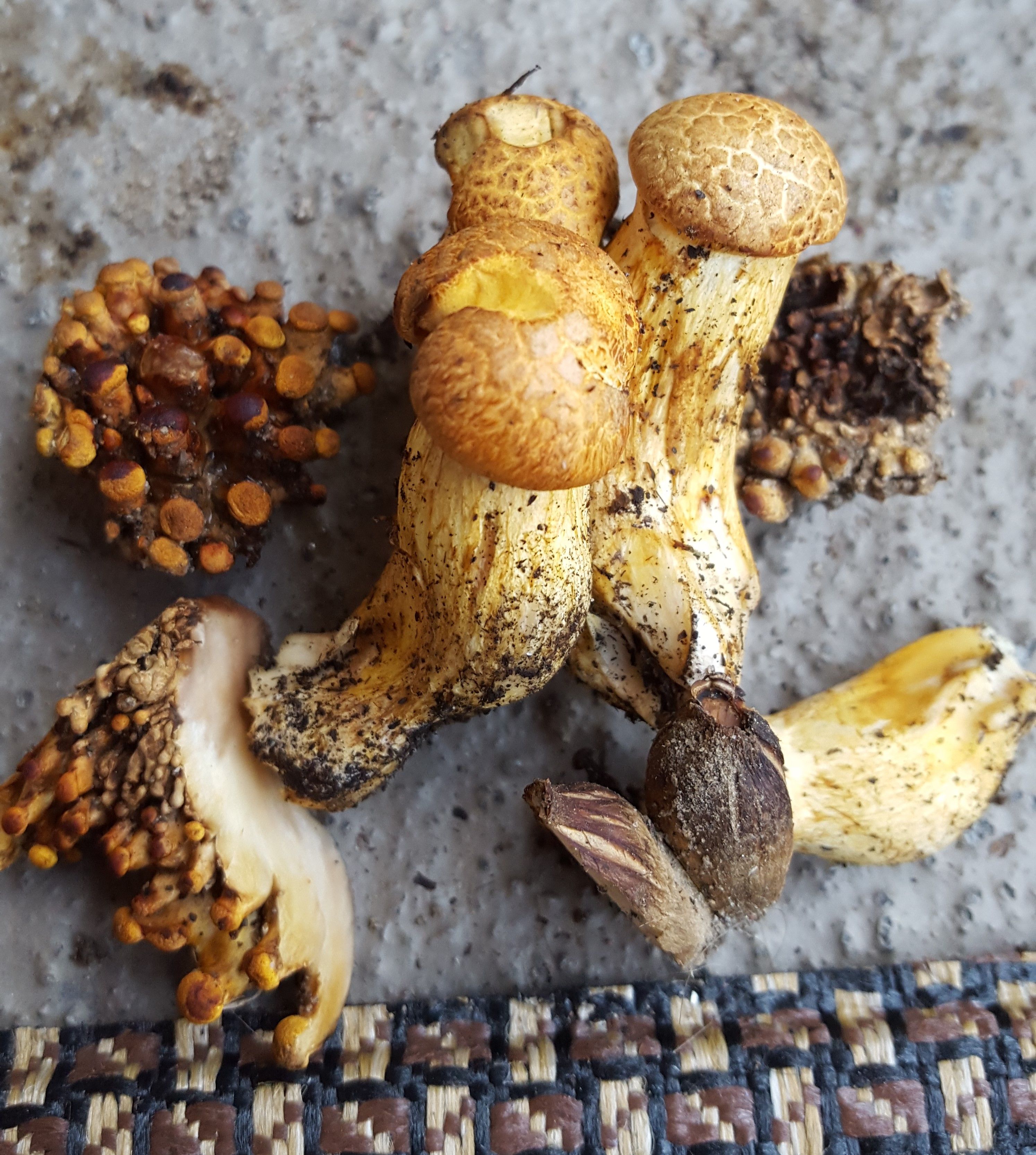
The mushrooms pictured in these posts are real weirdos.
Something is...wrong with them...and I don't know exactly what it is, though I have my theories.
These guys were all growing on several trees in my neighborhood. What's interesting - one of several interesting things - is that two of those trees were over half a mile apart from one another. Both were street trees living in their own deserted plots of dirt, and yet both were suffering from the same, potentially devastating, affliction.
I should say at this point that discovering these butt rot fungi, whatever their actual species, on these trees is a major blow for me. One of the trees must be nearly a hundred years old, possibly older. An oak, planted generations ago, that has seen the city develop around it. It stands quite majestically outside my apartment building and provides the most beautiful shade and coverage from rain on our narrow, one way street.
In recent months, I have become the grim reaper of local city trees. So far, and I am not proud of this, although I believe it was the right choice, I have been responsible for 311 calls which resulted in the removal of four different old growth trees in NYC. Each tree manifested a wide variety of either visible structural damage, or intensive fungal infection which implied a lack of overall health.
Now, I did not call 311 and say "Chop down these trees immediately!". I simply called and indicated a dead bough here, or a fungus there. I figured, at least for a couple of the trees, that there would some ameliorative action that could be taken, perhaps partial cutback or fungal treatments. But in each case, the tree was there one day, and gone the next.
To be fair, the stumps revealed a great deal of invisible damage, and I like to think, in the windy days since, that I may have saved a pedestrian or a car from falling limbs.
But, it still pains me to see them go. And it would so pain me to see this one go, that I can't bring myself to make the call.
Let's take a closer look at the dastardly tree killer.
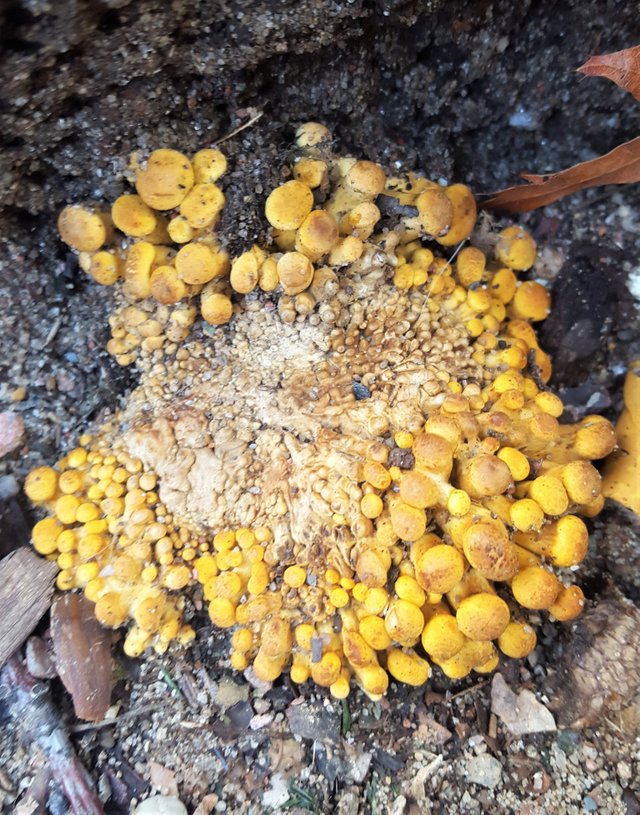
This unfortunately large cluster never really got off its feet.
Actually, none of the specimens featured here managed to mature. They all died well before that point, likely as a result of dog piss or the cold. Or any number of other possible hazards that might accost a mushroom in an urban environment.
Despite being stalled mid development, it's clear that whatever this fungal infection is, it is pretty advanced, and pretty eager to spread. This cluster of potential caps could have been a hundred strong had circumstances allowed it!
The entire bundle tore away in mostly a single mass, which I split into pieces for a closer look.
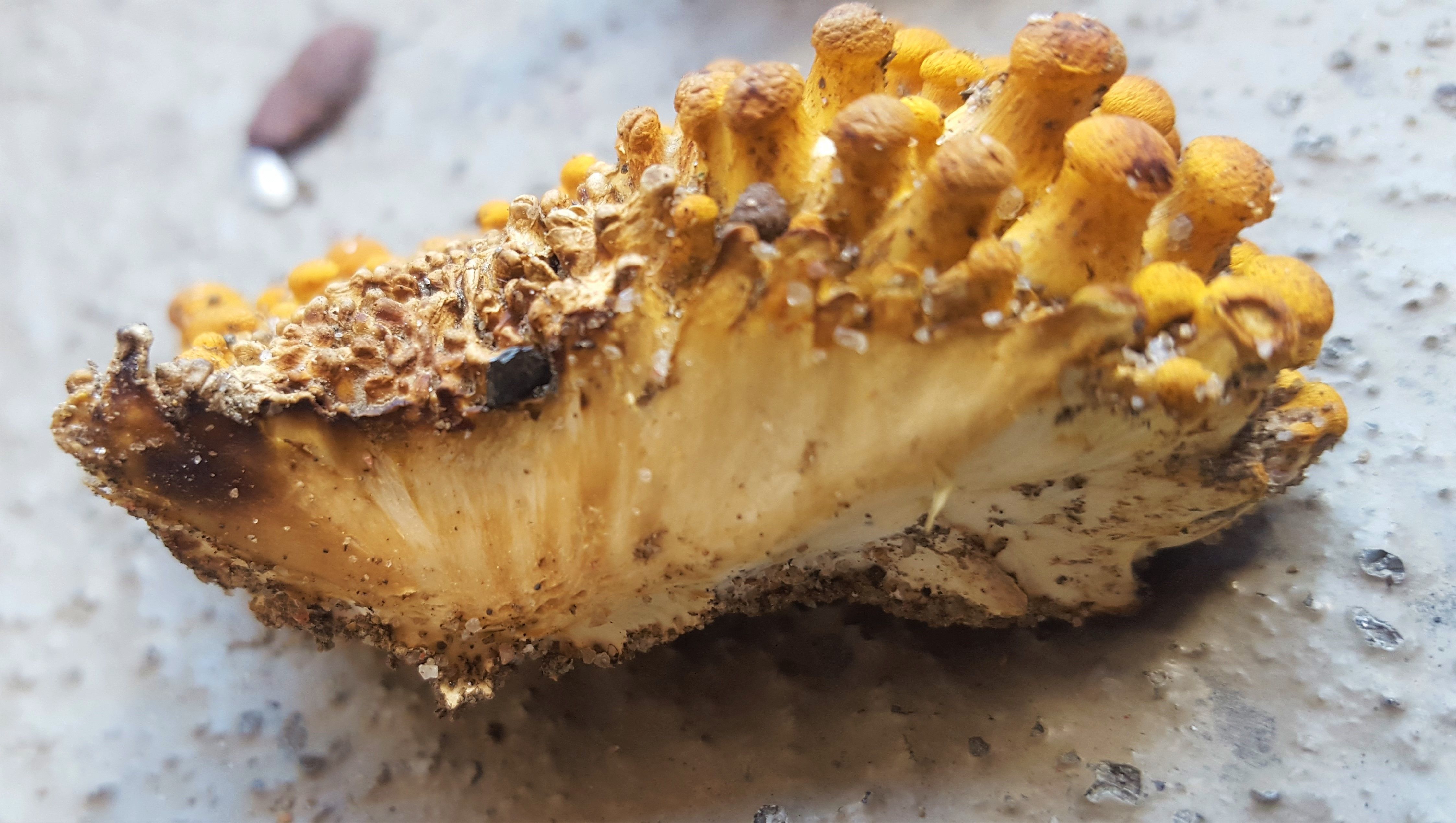
The cross section shows all of the caps forming from a shared sterile base.
The flesh of the base in whitish, but this older piece is also browning. The somewhat developed caps are bright yellow almost all around, while the tiny ones in the rear have begun to brown. The entire cluster, above, was a few inches in diameter, and the largest of the caps on it were a couple of cm in height.
You can see the hint of various dirt and detritus int his sample strewn about the surface. God only knows what was on these mushrooms, which makes it all the more impressive that they got to the point that they did even.
Other clusters were also present, and they revealed something even stranger.
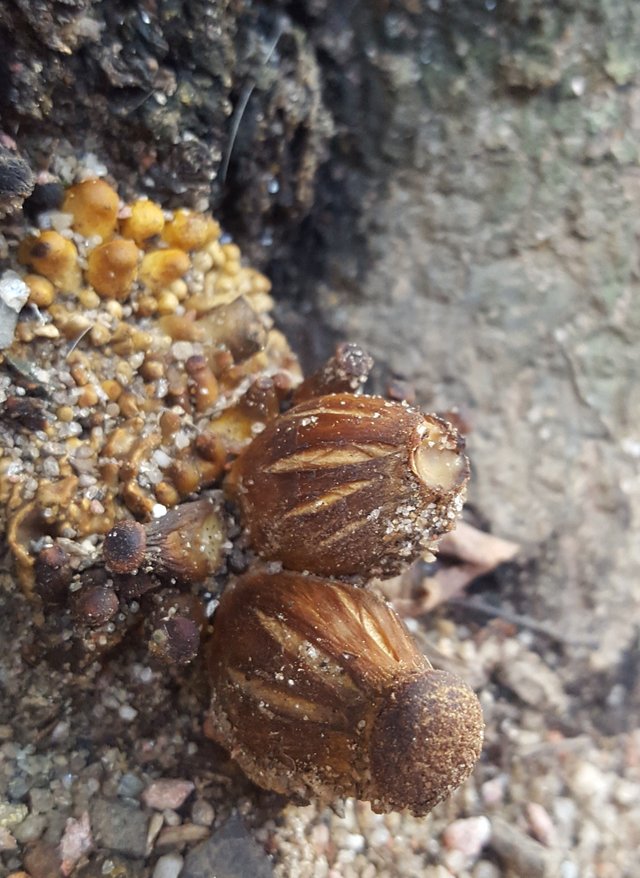
What the actual f#@K?
This is positively odd. Clearly we're look at a much older fruiting body - I believe of the same species since it was growing from the same tree where other clusters were growing and has some shared traits - internal white flesh, a textured cap, coming from a larger sterile mass.
But, obviously, these are also absolutely bizarre in their differences. Primarily, the bulbous stem, so thick and wide that both have cracked at the seams! Moreover the fruiting body on the top of the picture seems to have smoothly lost it's "cap", sort of like the smooth nubbin on the end of the Tulostoma lloydii I found once upon a time.
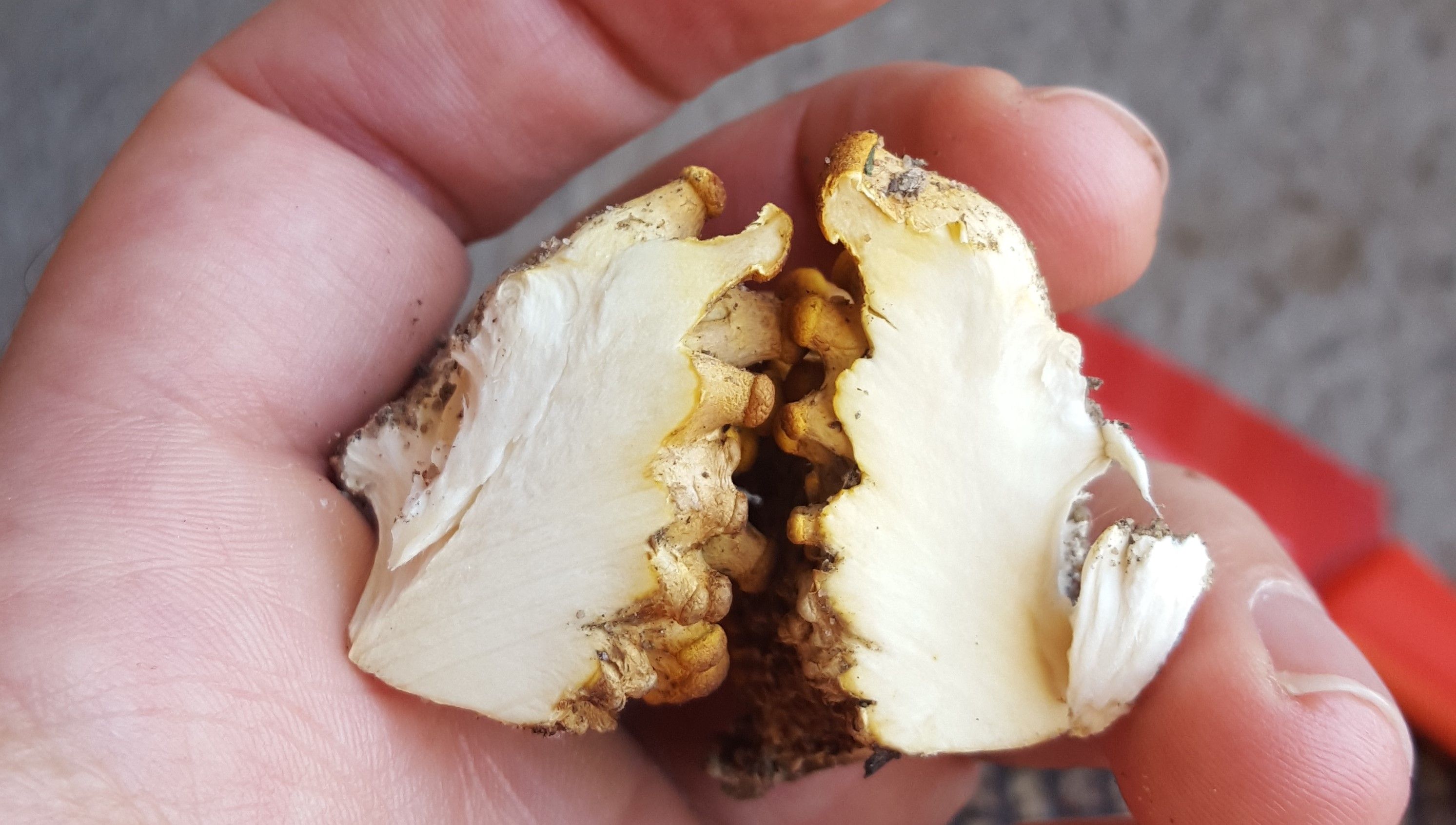
But this is not T.lloydii. This is not a puffball of any kind.
You can see in the photo to the left the halved sterile base of a slightly newer cluster of this mushroom - these clearly grow in large groups or florets and the flesh is white and undifferentiated in the base.
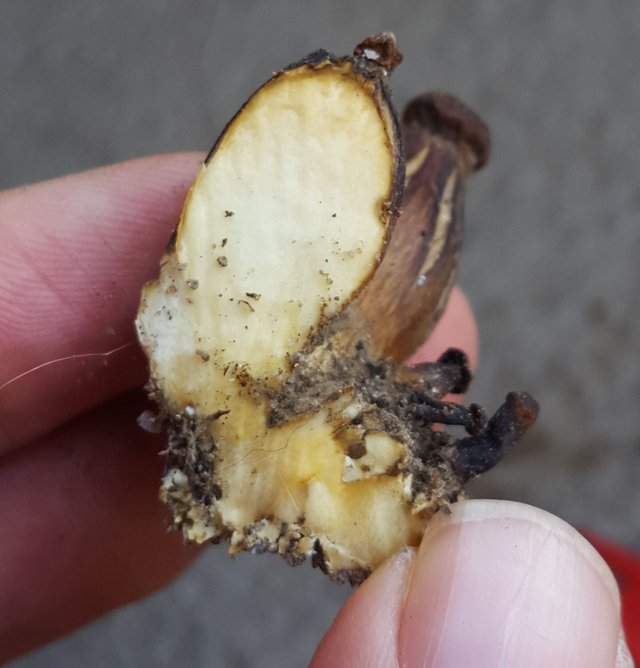
But it is also white and undifferentiated, even in the clearly older and much grosser abnormal specimen.
This mushroom appears to have a variety of morphological issues in that the caps never seem to properly develop. Instead the stem takes over development and grows almost out of control. These things remind me of the horrible out of control growth of Tetsuo in Akira.
It might have been plausible that these were simply a non-gilled species that developed and deployed their spores in a different way. But a closer look belies this possibility.
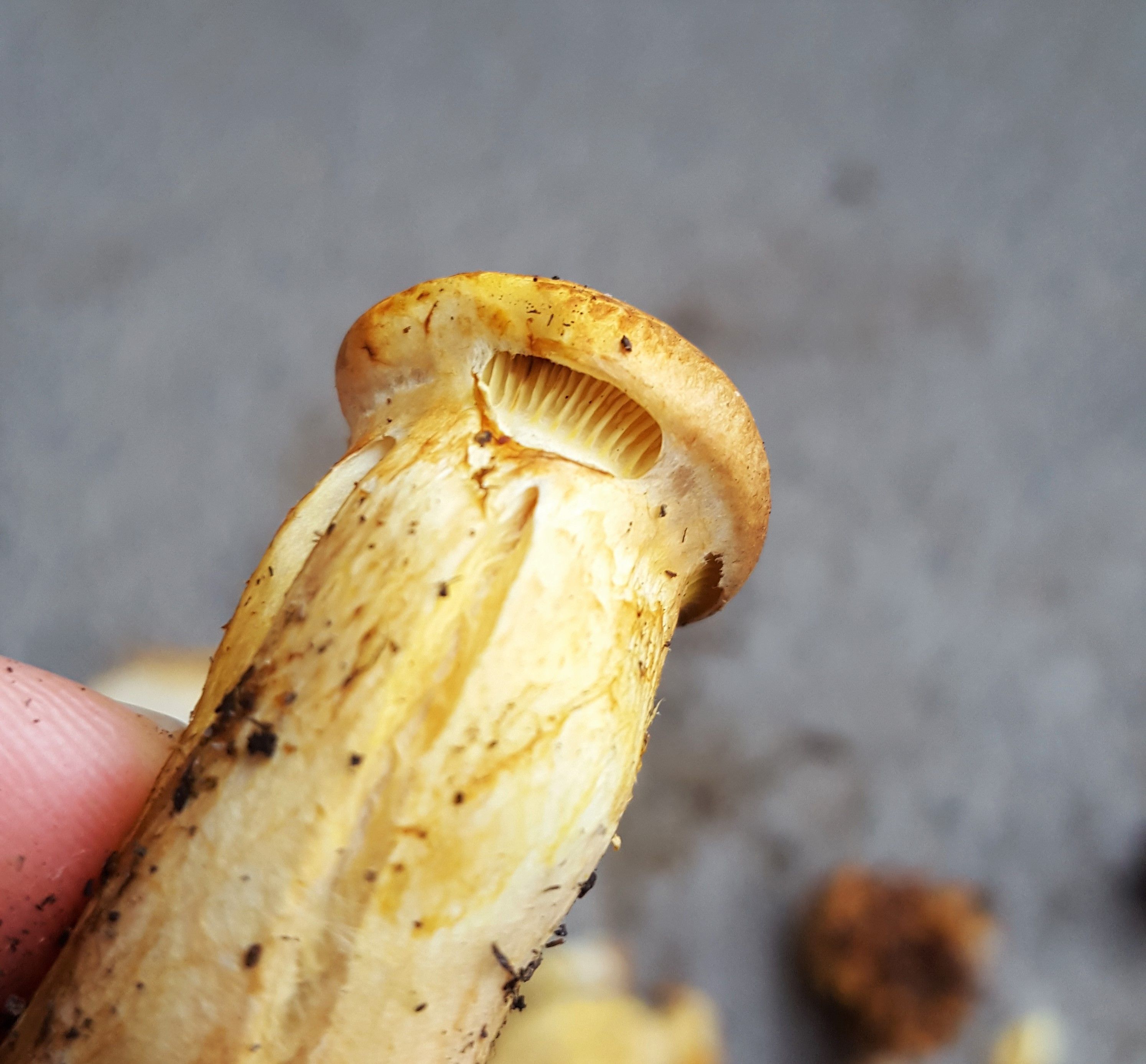
Tiny gills covered in a veil!
Here we have one of the largest specimens to come out of any of these clusters. You can see that the stem has once again grown way out of proportion to the cap and gills. However, unlike the other caps, this particular specimen has made a rudimentary effort. The gills were tiny and decurrent. They were also covered in a partial veil which began to break away.
It seems very unlikely indeed that this is the intended morphology of these mushrooms. It would be a gigantic amount of resources to waste on sterile stem material in lieu of actually productive spore producing surfaces. When I halved this stem, it was also undifferentiated, sterile white flesh throughout. There is some reticulation along the stem, but nothing floccose or straight of hairy.
Let's take a look at the cap and KOH reaction
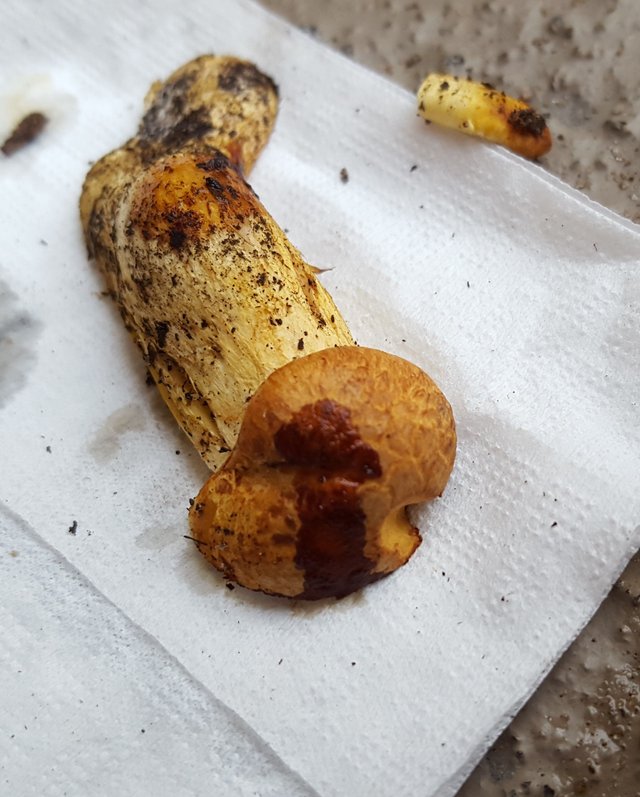
Even on the smaller caps there is a kind of reptilian scalyness.
You can see that here to an extent. The caps are definitely textured, though not with thick hairs or scales, more like the outline of scales. A drop of KOH on the cap surfaces is browning.
Conclusions
Given the fact that these are likely saprobic or parasitic in nature, growing from an oak tree in a position that suggest butt rot, I have to guess that they are part of the very wide genus Armillaria. Armillaria is both a genus of mushrooms, containing many species, and sometimes referred to as a complex of mushrooms. There is the Armillaria mellea complex - the "Honey Mushrooms", while others group the genus as a whole by the name Armillariella, although this seems less common.
Given the yellow, clustering, butt rot growth on a living tree, something in this complex/genus makes sense. Since there is a veil covering the rudimentary gills, we can then go on to say that this is probably in the A.mellea complex - the wide range of individual species which might be grouped in "Honey Mushrooms."
Another possibility I considered is that this was some sort of Pholiota species, possibly Pholiota multiflora. However Pholiota's are usually not parasitic, they appear to be pure saprobes and grow on already decomposing wood. This is not totally inconceivable, it could be that a portion of the butt has straight up died, but it's pretty unlikely.
No matter which species this is, it did not come to full maturation, which is good for the community of trees, as no or few spores would have been transmitted into the air. It's a little annoying for me as I was not able to take a print or collect useful microscopic information from the immature gills I found.
The takeaway is this - these are likely Armillaria mushrooms - the kind that parasitizes and eventually kills a wide variety of trees. This bodes, in the mid-term, poorly for the trees on which I found these mushrooms. Along with various polypores, primarily Ganodermas, Armillaria mushrooms can be a real tree killer. And, like Ganodermas, once you see the fruiting bodies, it usually means the invading mycelium has spread fairly completely.
For the land owner, or urban street walker, keep an eye out for this and other tree growing fungi. If you are a member of the public, you can call your municipality who can send out tree specialists, but just know that could be a death sentence for the tree. If you're a land owner and see this on one of your trees, definitely call a tree specialist as the best way to save your other trees might be to treat, or cull, the infected one.
Photos And Videos Are My Own:
Microscopic photos were taken using an AmScope SM-4TZ-144A dissecting microscope and an AMScope M150B entry level microscope. The camera lens is also AMScope, MU300.
Information Sources
The bulk of the information in this case was derived from a multi-part posting of these photos and the circumstances of their being taken on several forums involving the study of Fungi and Slime Molds. The information was shared on The Slime Mold Collective, The NYMS Facebook page, and the subreddits /r/mycology and /r/slimemolds. Users from the slime mold collective and reddit both expressed doubt that this was a slime mold and was in fact a fungal mold.
Efforts were made to identify the species using the following resources:
[1]Kuo, M. (2017, May). Armillaria mellea. Retrieved from the MushroomExpert.Com
[4]Kuo, M. (2017, May). Armillaria tabescens. Retrieved from the MushroomExpert.Com
[5]First Nature on A.tabescens
[6]The Audubon Society Field Guide To North American Mushrooms by Gary Lincoff, p.736, Honey Mushrooms.
[7]Mushrooms of the Northeastern United States and Eastern Canada by Timothy J Baroni, p.287, Pholiota multifolia
I dunno man. As an avid wild mushroom picker I love eating them. Except if it dose not look like a chanterelles, morels, or lobster mushrooms I wont touch them. On a side note... Boletaceae are a really cool mushroom family that you can write a message on with just by touching the gills. Yet these are poisonous so you gotta really wash your hands afterwards. I spent a lot of time as a kid in the scouts with a mushroom expert, there is definitely a cool world out there.
It's much better to be extra careful than it is to go outside of your comfort zone when it comes to foraging almost anything. It's awesome to have enough specialized knowledge to recognize just a few choice edibles
Yessssss!! I see you Chicken of the Woods and Lions Mane links. I like the edible ones more, but I love these kinds of posts :) I need to learn more about what is forageable in my area of the woods overall :)
Some of these posts have gotten pretty ultra specific in terms of their content - but the large finds are still some of the most exciting! Try to google a mycological club in your zipcode.
There are sooo many actually, I live in a very outdoorsy community... I just don't get out as much as I'd like because I work from my laptop, sigh.....!
Now you have to go around to each stump and hammer in some shiitake wooden dowels. That was the whole point of calling the hit jobs via 311 after all. This will be very delicious.
The hot wax is gonna be the big problem for my ninja inoculations - nothing a battery powered induction portable stovetop can't solve!
I watched enough US movies to know of 911, but not 311: when I read this, I thought you actually made 311 separate calls!
This series always has a sort of mystery/detective-feel to them, it draws you in and keeps you reading to the end. Nice job. And you did your public duty in this one to boot.
P.S. I wonder if realtors have any special instructions regarding selling property to mycologists, given how they apparently bring down the value of the neighborhood by stripping it of trees! :P
Haha - Lucky for local residents, all of the trees I've reported and gotten removed are outside the place where I work, so local property prices have likely not been affected.
Oh, and 311 is a New York City specific municipal phone number you can call for free. It has a ton of information - it's not just for lodging non-emergency complaints - and I think it's underutilized by tourists. I even think they will answer in a variety of different languages as well.
Lastima que no pudieras conseguir mas información valiosa con respecto a estos hongos. Excelente publicación.
no todos los hongos proporcionan muchos detalles. ¡hago lo mejor que puedo con lo que encuentro! gracias por leer.
I really hope you don't lose that oak tree. Thank you for another great write up, and educating me on what mushrooms to look out for with regards to trees. The identification process can me so lengthy, I really never realized how much until I came across your posts. Thanks again, for feeding my brain x
Unfortunately, as with everything I guess, it's probably only a matter of time. I am hesitant even to point it out to the building management - but they also have tree health folks stop by once a year - so I'm going to go on the assumption that they are aware of the problem, assessed it, and decided the tree has a number of years left.
Or they didn't see it, which is plausible because they come in the summer and this appeared in fall. Anyway, I refuse to be the bell tolling for this one. Too attached :)
So this type of mushroom is the cause of root rot? Mushrooms thrive in wet soil, since you found two trees half mile away have them, maybe that indicates the city has some drainage problems....
This would be one of many tree born fungi which cause root rot, yes. Not all fungi are the result of poor drainage or moisture problems. In nature fungi that grow as parasites on living trees will look for an in however they can. Street trees are very suscepible to fungal infections because they suffer a lot of physicaly abuse to their bark. Once the bark is damaged mushroom spores, which are everywhere, can get into the tree's interior wood and start to grow. Once you've seen the actual mushroom, like here, you can be pretty sure your tree has a pretty asvanced infection.
Do you wear a mask or any other sort of protective gear when you're chopping them up? I'd be a bit worried about inhaling some of this stuff, lol.
extraordinary postings deserve to be trending